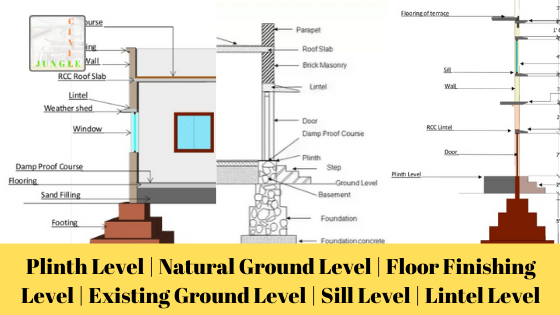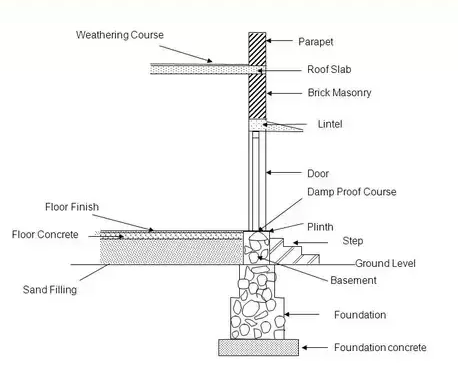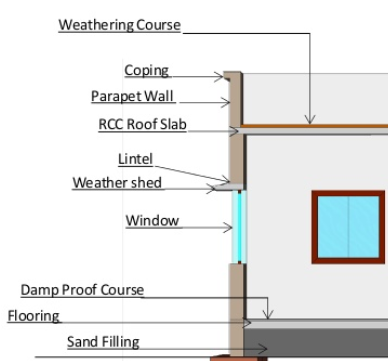Types of Level in Building Construction
Important Point
- Ground Leval / Floor Level
- Natural Ground Level
- Floor Finishing Level
- Existing Ground Level
- Plinth Level
- Sill Level
- Lintel Level
- Structural Floor Level (SFL)
- Structural Slab Level (SSL)
Ground Lavel
G.L. full name is Ground Level. F.L. full name is Floor Level. The term ‘Ground Floor’ or ‘Ground Level’ is used to refer to this level of a building that is at street/ground level.
The term ‘story’ tends to refer to all levels of a building above the Ground Level / Floor Level. It can also refer to this level of ground that hasn’t be built on.
This level of the ground before any excavation or filling has been carried out is referred to as the ‘Natural Ground Level,’ whereas ‘Finished Ground Level’ is when it has been ‘Finished’ with paving stones, asphalt, landscaped grass, and so on.
Also, read: What Is Specific Gravity Cement | Why We Calculate Specific Gravity Cement | Specific Gravity Test on Cement
Natural Ground Level
N.G.L. full name is Natural Ground Level. The natural ground level is termed as the level of the ground. The height of Natural ground level (NGL) is generally measured with the Mean-sea level.
A natural ground level is what “mother earth” has provided us, and an existing ground level may be either cut or filled and, therefore, a different elevation than the original natural ground level.
Floor Finishing Level
F.F.L. full name is Floor Finishing Level. The ground level inside the building is knowns Floor Finish level. This level is at the height of a minimum 150mm – 450mm from the Natural ground level (N.G.L).
The reason for raising building height is to restrict the entry of water during storms and rainfall. The height may go up to meters if the building located in slope and heavy rainfall areas. Natural assume of F.F.L near about 100.oo m R.L.
Also, read: Concrete Mix Ratio | What Is Concrete Mix Ratio | Type of Concrete Mix Ratio
Existing Ground Level
E.G.L. full name of Existing Ground Level. After earth filling of above natural ground level that above the level surface, this surface area called the existing ground level. E.G.L. normally after filling soil compaction.
Plinth Level
The plinth is the part of the superstructure between the top of the tie beam at the finished ground level (the top level of the soil surrounding the structure that has been prepared and leveled before construction) and the floor level of the building( the ground floor level inside the building).
The plinth height is provided essentially to protect the superstructure from dampness, which may seep in due to direct contact from the ground. The top plinth level is provided with the damp proof course, which is additional protection against dampness.
This is the portion of structure between the surface of the surrounding ground and surface of the floor, immediately above the ground.
As per Byelaws, the plinth should not be less than 45cm. The basic requirements of plinth area
- To transmit this load of the superstructure to the foundation
- To act as a retaining wall to keep the filling portion below the raised floor or the building
- To protect the building from damp or moisture penetration into it
- It enhances the architectural appearance of the building
Also, read: What is Plum Concrete | Application | Mix Design | Methodology
Sill Level
A level between the building’s window base and floor level above ground level is known as the sill level. The concrete bed or mortar bed is placed at the window base level. Granite is also used at the base level of the window. Sill level height varies from room to room and depends on the room type.
The window finishes at the top at the lintel level. A window sill may be equal to or greater than the width of the brickwork beneath it.
This level between the base portion of the window and portion of the floor above ground level (upwards) is called the Sill level. A mortar bed or concrete bed is laid at the base of the window. The height of the sill level depends upon the type of room for bedroom & bathroom height.
Lintel Level
The lintel level is the height or vertical measurement from the bottom edge to the top horizontal component of a window or door, the lintel is provided above the doors and windows to transfer the upward wall load to the surrounding wall.
The level between the top portion of the window and the top slab is called the Lintel level. The lintel is generally made up of Reinforced concrete or cement mortar.
The actual frame of the door or window is not strong enough to support the weight of the wall above the strong enough to support the weight of the wall above the openings, and a separate structural element has, therefore, to be introduced. This is known as a lintel. This lintel area level also is known as lintel level.
Also, read: Piling for Foundation | Use of Pile Foundation | Characteristics of Pile Foundation
Difference Between Plinth Level, Sill Level, and Lintel Level.
| Sr.No. | Plinth Level | Sill Level | Lintel Level |
|---|---|---|---|
| 1 | The plinth is the part of the superstructure between the top of the tie beam at the finished ground level | Sill level is the part of window . Window sill are provided between the bottom of window frame and wall below | Lintel beam the actual frame of door or window is not strong enough to support the weight of the wall above the opening and separate structural element has, therefore to be introduced. this known as lintel and similar to a beam |
| 2 | This level of below the floor finishing . This level constructed beam that beam called Tie beam. | This level between the base portion of the window and portion of the floor above ground level (upwards) is called the Sill level. A mortar bed or concrete bed is laid at the base of the window. | The level between the top portion of the window and the top slab is called the Lintel level. |
| 3 | The plinth is generally made up of Reinforced concrete or cement mortar. | The sill is generally made up of Reinforced concrete or cement mortar. | The lintel is generally made up of Reinforced concrete or cement mortar. |
| 4 | The plinth is provided to act as a barrier against rainwater and stormwater to support a dead load of masonry above it. | Sill is provided to base for the window. | A lintel is provided to carry the load of masonry above the opening. |
| 5 | Plinth height between 300 to 450 mm above the ground level is taken. | Sill beam level from floor finishing level for 1100 mm and 600-650 mm for the drawing-room is adopted. | While the height for sill 2130 mm (7′) in residential and 2316 mm (7’6″) in commercial in most of the cases. |
Plinth Level Meaning
The point where the substructure and superstructure of a building meet are called the plinth level. In simple terms, this is where the substructure of the building (footing) ends and the superstructure starts (columns).
Plinth Level
Plinth Level means the level of the ground floor of a building with respect to the adjoining ground. Plinth Level means the level of the ground floor of a building. Plinth Level means the level of the ground floor of abuilding above the surrounding ground.
Lintel Height
The height between the floor level and lintel level is referred to as lintel height. As per the building regulations, the preferable lintel height adopted for the residential building is 7′ (2.1 m ) and for the commercial buildings is 7’6”(2.3 m).
Sill Level Meaning
The level between the base portion of the window and portion of the floor above ground level (upwards) is called Sill level. Mortar bed or concrete bed is laid at the base of the window.
Plinth Level Height
It is the part of the superstructure between natural ground level and Finished floor level. the plinth is provided to restrict the seepage of stormwater and rainwater into the building. The plinth height is in between 300mm – 450 mm from ground level.
Window Sill Height
Sill Level – The level or distance from the floor to the bottom of the window frame is called the Sill level. It is generally kept about 900 mm or 3 ft. The level from the top of the floor level to the top of the door frame on which lintel is placed is called the Lintel level.
What Is Ground Level?
The term ‘ground level‘, or ‘ground floor‘, is used to refer to the level of a building that is at ground / street level. The term ‘storey’ tends to refer to all levels of a building above the ground level. It can also refer to the level of ground that has not be built on.
Lintel and Sill
A lintel or lintol is a structural horizontal block that spans the space or opening between two vertical supports. In the case of windows, the bottom span is instead referred to as a sill, but, unlike a lintel, does not serve to bear a load to ensure the integrity of the wall.
What is Plinth Level?
The plinth level is basically the level that stays between the original ground level and the finished floor level of the building. The original ground level is the topmost layer of the soil present around the structure.
What Is Existing Ground Level?
Existing Ground Level (EGL) means the level of the referred point of the exposed surface of the ground, road or pavement free from extraneous materials and High Flood Level (HFL) or Finished Ground Level (FGL) is the referred top most point of the nearby road shown in site plan.
What Is Natural Ground-Level?
The level of the ground before any excavation or filling has been carried out is referred to as the ‘natural ground level’, whereas ‘finished ground level’ is when it has been ‘finished’ with paving stones, asphalt, landscaped grass, and so on.
Sill Level Height
Sill level is height or distance between bottom of window frame to floor level, Generally, it is kept around 900mm (3 feet) height above floor level. While lintel height is height or distance between top of door frame to floor level, Generally, it is kept around 2.1m (7 feet) height above floor level.
What Is Sill Level?
This level between the base portion of the window and portion of the floor above ground level (upwards) is called the Sill level. A mortar bed or concrete bed is laid at the base of the window. The level between the top portion of the window and the top slab is called the Lintel level.
Floor Finishing Level
Finished floor level (FFL) refers to the uppermost surface of a floor once construction has been completed but before any finishes have been applied. Floor levels and other vertical dimensions are usually expressed in meters to three decimal places, e.g FFL 16,550.
Lintel Level of a House
The lintel level is the height or vertical measurement from the bottom edge to the top horizontal component of a window or door, the lintel is provided above the doors and windows to transfer the upward wall load to the surrounding wall.
Plinth in Building
A plinth level forms the foundation of a house. It is a rectangular block of stone on which a column and pillar of a building stands. It is a wall between the ground level and the ground floor level. The main function of a plinth in construction is to distribute the load of the columns over the foundation evenly.
Plinth of a Building
A plinth level forms the foundation of a house. It is a rectangular block of stone on which a column and pillar of a building stands. It is a wall between the ground level and the ground floor level. The main function of a plinth in construction is to distribute the load of the columns over the foundation evenly.
What Is Floor Level ?
Floor Level means the floor upon which people normally walk—not shelves, ledges, overhead beams, tops of stacked materials, surfaces of equipment, or similar places.
What Is Floor Finishing Level?
The Finished Floor Level (FFL) is the level, or height, at which the floor of a building or structure (including alterations and additions) is proposed to be built.
What Is Lintel Level?
This is the just above the window and door frame to take load coming from wall which is above the window and door frame. It may be of concrete, wooden, R.C.C., stone, etc.
Like this post? Share it with your friends!
Suggested Read –
- What Is EDM in Surveying | Type | Errors
- Total Station in Surveying | Operations | Advantage & Disadvantage | Types
- What Is Linear Measurement Surveying | Type of Linear Measurement Surveying
- Principle of Plane Table Surveying Methods | Equipment | Error | Advantage | Limitation
- Benchmark in Surveying | TBM in Surveying | GTS Benchmark| Permanent Benchmark| Arbitrary Benchmark
Originally posted 2023-05-31 01:07:47.





Leave a Reply